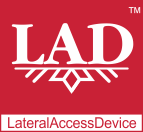
LateralAccessDevice
takes you back to before the Internet
How It Works | Download LAD | Support | LAD Security | Features & Uses | Resources | Members | User Guide
Getting Started with LADOnce you have LateralAccessDevice installed on your hardware and set up on your network, you may wonder "what now?" The simplest way to get started is to log in and see what there is to see. When you log in to LAD, on the main menu you will see a list of all your devices (if you have more than nine, the list will spill over to a separate page). LAD will try to figure out the names of the devices (oftentimes using the MAC address), but you can nickname them as you choose, for convenience. As your computers and other networked devices do their thing, the LAD system will automatically detect them and track their activity. Take a look at the reports, perhaps first looking at the general report on internet usage, and then looking at the reports for individual devices, which can give you an immediate perspective on what is going on. Or, take a look at the DNS logs — you may be surprised at what you find. The DNS logs may be the easiest place to start. From the logs you can limit which domain names an individual computer or device may access by clicking on the "blacklist" icon right in the log. You will likely see a lot of domain names corresponding to the various ad networks. It may be a good idea to block them, and not just because it is annoying to be bombarded with ads wherever you go (even though it is). Back in 2013 we pioneered research into the dark side of the ad networks with the release of our report "Marketing Cybercrime to Infect America." As we reported back then, hackers have discovered a nifty way to get into your life through the ads that you had no choice but to view when you went on the Internet. While you may think that the online ads are simply digital versions of an print advertisement you might see in a magazine, the truth is that it is far removed and online ads have become pernicious ways to compromise whosoever may see them. One strategy for handling suspicious domain names is to simply block them and see if anything stops working like it should. If it does, it's simple to unblock. If you don't notice any difference, leave it blocked and don't give it another thought. Another strategy is more pointed: don't like your kids' computer connecting to Facebook when they should be doing homework? You can block the domain name with a click. You may ask why this process isn't automated. The answer is simple. You are the one who best knows how you use your Internet connection, whether you only use it in the evenings or check email round the clock or have gaming marathons on the weekends. No automated system could know what is normal and what is out of place as well as you do. Do you need to check reports every day? Well, that is up to you, depending on your needs and circumstances. Many may find it most efficient (and still effective) to click around the reports every so often, just to see if anything odd or out of place catches their eye. |